16 Oracle CQL Statements
This chapter describes the various Oracle CQL data definition language (DDL) and data modification language (DML) statements that Oracle CEP supports.
16.1 Introduction to Oracle CQL Statements
Oracle CQL supports the following DDL statements:
Note:
In stream input examples, lines beginning withh (such as h 3800) are heartbeat input tuples. These inform Oracle CEP that no further input will have a timestamp lesser than the heartbeat value.For more information, see:
Query
Use the query statement to define a Oracle CQL query that you reference by identifier in subsequent Oracle CQL statements.
If your query references a stream or view, then the stream or view must already exist.
If the query already exists, Oracle CEP server throws an exception.
For more information, see:
You express a query in a <query></query> element as Example 16-1 shows. Specify the identifier as the query element id attribute.
Example 16-1 Query in a <query></query> Element
<query id="q0"><![CDATA[
select * from OrderStream where orderAmount > 10000.0
]]></query>
query::=
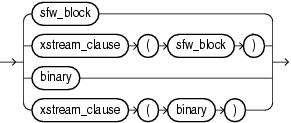
(sfw_block::=, xstream_clause::=, binary::=)
sfw_block::=
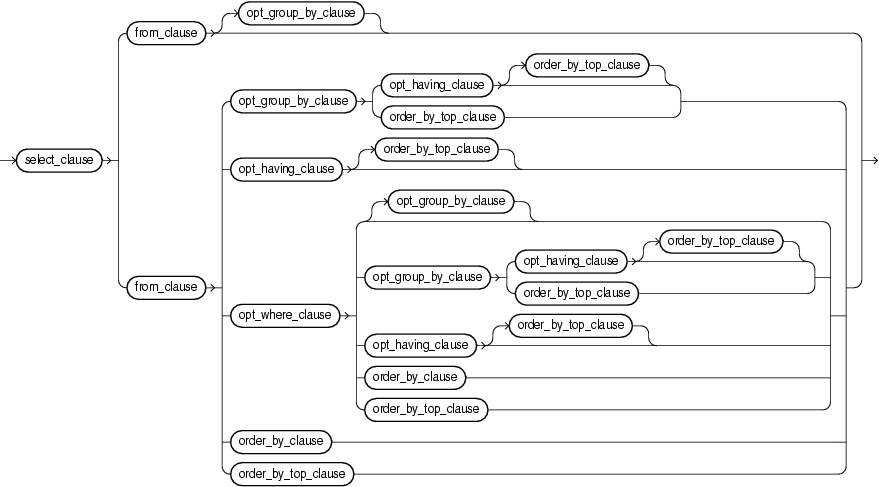
(select_clause::=, from_clause::=, opt_where_clause::=, opt_group_by_clause::=, order_by_clause::=, order_by_top_clause::=, opt_having_clause::=)

projterm::=
from_clause::=

(non_mt_relation_list::=, relation_variable::=, non_mt_cond_list::=)
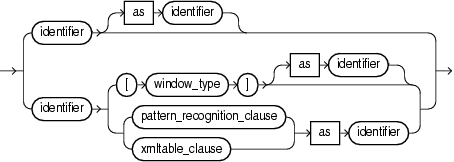
(identifier::=, window_type::=, pattern_recognition_clause::=, xmltable_clause::=)
window_type::=
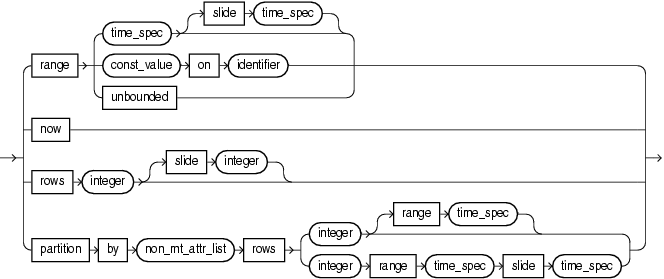
(identifier::=, non_mt_attr_list::=, time_spec::=)

(pattern_partition_clause::=, order_by_list::=)
orderterm::=

(order_expr::=, null_spec::=, asc_desc::=)
null_spec::=

asc_desc::=

binary::=
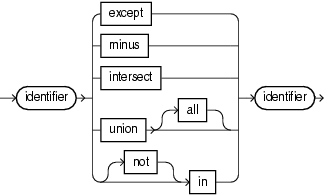

(xmlnamespace_clause::=, const_string::=, xqryargs_list::=, xtbl_cols_list::=)


Specify the Oracle CQL query statement itself (see "query").
If you plan to configure the query with USE UPDATE SEMANTICS, you must declare one or more stream elements as a primary key (out_of_line_constraint::=).
For syntax, see "Query".
You can create an Oracle CQL query from any of the following clauses:
-
sfw_block: a select, from, and other optional clauses (see "sfw_block"). -
binary: an optional set operation clause (see "binary"). -
xstream_clause: apply an optional relation-to-stream operator to yoursfw_blockorbinaryclause to control how the query returns its results (see "xstream_clause").
For syntax, see query::=.
Specify the select, from, and other optional clauses of the Oracle CQL query. You can specify any of the following clauses:
-
select_clause: the stream elements to select from the stream or view you specify (see "select_clause"). -
from_clause: the stream or view from which your query selects (see "from_clause"). -
opt_where_clause: optional conditions your query applies to its selection (see "opt_where_clause") -
opt_group_by_clause: optional grouping conditions your query applies to its results (see "opt_group_by_clause") -
order_by_clause: optional ordering conditions your query applies to its results (see "order_by_clause") -
order_by_top_clause: optional ordering conditions your query applies to the top-nelements in its results (see "order_by_top_clause") -
opt_having_clause: optional clause your query uses to restrict the groups of returned stream elements to those groups for which the specifiedconditionisTRUE(see "opt_having_clause")
For syntax, see sfw_block::= (parent: query::=).
Specify the select clause of the Oracle CQL query statement.
If you specify the asterisk (*), then this clause returns all tuples, including duplicates and nulls.
Otherwise, specify the individual stream elements you want (see "non_mt_projterm_list").
Optionally, specify distinct if you want Oracle CEP to return only one copy of each set of duplicate tuples selected. Duplicate tuples are those with matching values for each expression in the select list. For an example, see "Select and Distinct Examples".
For syntax, see select_clause::= (parent: sfw_block::=).
Specify the projection term ("projterm") or comma separated list of projection terms in the select clause of the Oracle CQL query statement.
For syntax, see non_mt_projterm_list::= (parent: select_clause::=).
Specify a projection term in the select clause of the Oracle CQL query statement. You can select any element from any of stream or view in the from_clause (see "from_clause") using the identifier of the element.
Optionally, you can specify an arithmetic expression on the projection term.
Optionally, use the AS keyword to specify an alias for the projection term instead of using the stream element name as is.
For syntax, see projterm::= (parent: non_mt_projterm_list::=).
Specify the from clause of the Oracle CQL query statement by specifying the individual streams or views from which your query selects (see "non_mt_relation_list").
To perform an outer join, use the LEFT or RIGHT OUTER JOIN ... ON syntax. To perform an inner join, use the WHERE clause.
For more information, see:
For syntax, see from_clause::= (parent: sfw_block::=).
Specify the stream or view ("relation_variable") or comma separated list of streams or views in the from clause of the Oracle CQL query statement.
For syntax, see non_mt_relation_list::= (parent: from_clause::=).
Use the relation_variable statement to specify a stream or view from which the Oracle CQL query statement selects.
You can specify a previously registered or created stream or view directly by its identifier you used when you registered or created the stream or view. Optionally, use the AS keyword to specify an alias for the stream or view instead of using its name as is.
To specify a built-in stream-to-relation operator, use a window_type clause (see "window_type"). Optionally, use the AS keyword to specify an alias for the stream or view instead of using its name as is.
To apply advanced comparisons optimized for data streams to the stream or view, use a pattern_recognition_clause (see "pattern_recognition_clause"). Optionally, use the AS keyword to specify an alias for the stream or view instead of using its name as is.
To process xmltype stream elements using XPath and XQuery, use an xmltable_clause (see "xmltable_clause"). Optionally, use the AS keyword to specify an alias for the stream or view instead of using its name as is.
To perform an outer join, use the LEFT or RIGHT OUTER JOIN ... ON syntax. To perform an inner join, use the WHERE clause.
For more information, see:
For syntax, see relation_variable::= (parent: non_mt_relation_list::=).
Specify a built-in stream-to-relation operator.
For more information, see Section 1.1.3, "Stream-to-Relation Operators (Windows)".
For syntax, see window_type::= (parent: relation_variable::=).
Specify the time over which a range or partitioned range sliding window should slide.
Default: if units are not specified, Oracle CEP assumes [second|seconds].
For more information, see "Range-Based Stream-to-Relation Window Operators" and "Partitioned Stream-to-Relation Window Operators".
For syntax, see time_spec::= (parent: window_type::=).
Specify the (optional) where clause of the Oracle CQL query statement.
For syntax, see opt_where_clause::= (parent: sfw_block::=).
Specify the (optional) GROUP BY clause of the Oracle CQL query statement. Use the GROUP BY clause if you want Oracle CEP to group the selected stream elements based on the value of expr(s) and return a single (aggregate) summary result for each group.
Expressions in the GROUP BY clause can contain any stream elements or views in the FROM clause, regardless of whether the stream elements appear in the select list.
The GROUP BY clause groups stream elements but does not guarantee the order of the result set. To order the groupings, use the ORDER BY clause.
For syntax, see opt_group_by_clause::= (parent: sfw_block::=).
Specify the ORDER BY clause of the Oracle CQL query statement as a comma-delimited list ("order_by_list") of one or more order terms (see "orderterm"). Use the ORDER BY clause to specify the order in which stream elements on the left-hand side of the rule are to be evaluated. The expr must resolve to a dimension or measure column.
For more information, see Section 14.2.6, "Sorting Query Results".
For syntax, see order_by_clause::= (parent: sfw_block::=).
Specify the ORDER BY clause of the Oracle CQL query statement as a comma-delimited list ("order_by_list") of one or more order terms (see "orderterm") followed by a ROWS keyword and integer number (n) of elements. Use this form of the ORDER BY clause to select the top-n elements over a stream or relation. This clause always returns a relation.
Consider the following example queries:
-
At any point of time, the output of the following example query will be a relation having top 10 stock symbols throughout the stream.
select stock_symbols from StockQuotes order by stock_price rows 10
-
At any point of time, the output of the following example query will be a relation having top 10 stock symbols from last 1 hour of data.
select stock_symbols from StockQuotes[range 1 hour] order by stock_price rows 10
For more information, see
For syntax, see order_by_top_clause::= (parent: sfw_block::=).
Specify a comma-delimited list of one ore more order terms (see "orderterm") in an (optional) ORDER BY clause.
For syntax, see order_by_list::= (parent: order_by_clause::=).
A stream element (attr::=) or positional index (constant int) to a stream element. Optionally, you can configure whether or not nulls are ordered first or last using the NULLS keyword (see "null_spec").
order_expr (order_expr::=) can be an attr or constant_int. The attr (attr::=) can be any stream element or pseudo column.
For syntax, see orderterm::= (parent: order_by_list::=).
Specify whether or not nulls are ordered first (NULLS FIRST) or last (NULLS LAST) for a given order term (see "orderterm").
For syntax, see null_spec::= (parent: orderterm::=).
Specify whether an order term is ordered in ascending (ASC) or descending (DESC) order.
For syntax, see asc_desc::= (parent: orderterm::=).
Use the HAVING clause to restrict the groups of returned stream elements to those groups for which the specified condition is TRUE. If you omit this clause, then Oracle CEP returns summary results for all groups.
Specify GROUP BY and HAVING after the opt_where_clause. If you specify both GROUP BY and HAVING, then they can appear in either order.
For an example, see "HAVING Example".
For syntax, see opt_having_clause::= (parent: sfw_block::=).
Use the binary clause to perform set operations on the tuples that two streams or views return.
For examples, see:
For syntax, see binary::= (parent: query::=).
Use an xstream_clause to specify a relation-to-stream operator that applies to the query.
For more information, see Section 1.1.4, "Relation-to-Stream Operators".
For syntax, see xstream_clause::= (parent: query::=).
Use an xmltable_clause to process xmltype stream elements using XPath and XQuery. You can specify a comma separated list (see xtbl_cols_list::=) of one or more XML table columns (see xtbl_col::=), with or without an XML namespace.
For examples, see:
For syntax, see xmltable_clause::= (parent: relation_variable::=).
Use a pattern_recognition_clause to perform advanced comparisons optimized for data streams.
For more information and examples, see Chapter 15, "Pattern Recognition With MATCH_RECOGNIZE".
For syntax, see pattern_recognition_clause::= (parent: relation_variable::=).
The following examples illustrate the various semantics that this statement supports:
For more examples, see Chapter 14, "Oracle CQL Queries, Views, and Joins".
Example 16-2 shows how to register a simple query q0 that selects all (*) tuples from stream OrderStream where stream element orderAmount is greater than 10000.
<query id="q0"><![CDATA[
select * from OrderStream where orderAmount > 10000.0
]]></query>
Consider the query q4 in Example 16-3 and the data stream S2 in Example 16-4. Stream S2 has schema (c1 integer, c2 integer). The query returns the relation in Example 16-5.
<query id="q4"><![CDATA[
select
c1,
sum(c1)
from
S2[range 10]
group by
c1
having
c1 > 0 and sum(c1) > 1
]]></query>
Example 16-4 HAVING Stream Input
Timestamp Tuple 1000 ,2 2000 ,4 3000 1,4 5000 1, 6000 1,6 7000 ,9 8000 ,
BINARY Example: UNION and UNION ALL
Given the relations R1 and R2 in Example 16-7 and Example 16-8, respectively, the UNION query q1 in Example 16-6 returns the relation in Example 16-9 and the UNION ALL query q2 in Example 16-6 returns the relation in Example 16-10.
Example 16-6 Set Operators: UNION Query
<query id="q1"><![CDATA[
R1 UNION R2
]]></query>
<query id="q2"><![CDATA[
R1 UNION ALL R2
]]></query>
Example 16-7 Set Operators: UNION Relation Input R1
Timestamp Tuple Kind Tuple 200000: + 20,0.2 201000: - 20,0.2 400000: + 30,0.3 401000: - 30,0.3 100000000: + 40,4.04 100001000: - 40,4.04
Example 16-8 Set Operators: UNION Relation Input R2
Timestamp Tuple Kind Tuple
1002: + 15,0.14
2002: - 15,0.14
200000: + 20,0.2
201000: - 20,0.2
400000: + 30,0.3
401000: - 30,0.3
100000000: + 40,4.04
100001000: - 40,4.04
Example 16-9 Set Operators: UNION Relation Output
Timestamp Tuple Kind Tuple
1002: + 15,0.14
2002: - 15,0.14
200000: + 20,0.2
201000: - 20,0.2
400000: + 30,0.3
401000: - 30,0.3
100000000: + 40,4.04
100001000: - 40,4.04
Example 16-10 Set Operators: UNION ALL Relation Output
Timestamp Tuple Kind Tuple
1002: + 15,0.14
2002: - 15,0.14
200000: + 20,0.2
200000: + 20,0.2
20100: - 20,0.2
201000: - 20,0.2
400000: + 30,0.3
400000: + 30,0.3
401000: - 30,0.3
401000: - 30,0.3
100000000: + 40,4.04
100000000: + 40,4.04
10001000: - 40,4.04
100001000: - 40,4.04
Given the relations R1 and R2 in Example 16-12 and Example 16-13, respectively, the INTERSECT query q1 in Example 16-11 returns the relation in Example 16-14.
Example 16-12 Set Operators: INTERSECT Relation Input R1
Timestamp Tuple Kind Tuple 1000: + 10,30 1000: + 10,40 2000: + 11,20 3000: - 10,30 3000: - 10,40
Example 16-13 Set Operators: INTERSECT Relation Input R2
Timestamp Tuple Kind Tuple 1000: + 10,40 2000: + 10,30 2000: - 10,40 3000: - 10,30
Example 16-14 Set Operators: INTERSECT Relation Output
Timestamp Tuple Kind Tuple 1000: + 10,30 1000: + 10,40 1000: - 10,30 1000: - 10,40 1000: + 10,40 2000: + 11,20 2000: - 11,20 2000: + 10,30 2000: - 10,40 3000: - 10,30
Given the relations R1 and R2 in Example 16-16 and Example 16-17, respectively, the MINUS query q1 in Example 16-15 returns the relation in Example 16-18.
Example 16-16 Set Operators: MINUS Relation Input R1
Timestamp Tuple Kind Tuple 1500: + 10,40 2000: + 10,30 2000: - 10,40 3000: - 10,30
Example 16-17 Set Operators: MINUS Relation Input R2
Timestamp Tuple Kind Tuple 1000: + 11,20 2000: + 10,40 3000: - 10,30
Example 16-18 Set Operators: MINUS Relation Output
Timestamp Tuple Kind Tuple 1000: + 10,40.0 2000: - 10,40.0
Consider the query q1 in Example 16-19. Given the data stream S in Example 16-20, the query returns the relation in Example 16-21.
Example 16-19 Select DISTINCT Query
<query id="q1"><![CDATA[
SELECT DISTINCT FROM S WHERE c1 > 10
]]></query>
Example 16-20 Select DISTINCT Stream Input
Timestamp Tuple 1000 23 2000 14 3000 13 5000 22 6000 11 7000 10 8000 9 10000 8 11000 7 12000 13 13000 14
Consider the query q1 in Example 16-22 and the data stream S in Example 16-23. Stream S has schema (c1 xmltype). The query returns the relation in Example 16-24. For more information, see Section 14.2.5, "XMLTable Query".
<query id="q1"><![CDATA[
SELECT
X.Name,
X.Quantity
from
S1
XMLTable (
"//item" PASSING BY VALUE S1.c2 as "."
COLUMNS
Name CHAR(16) PATH "/item/productName",
Quantity INTEGER PATH "/item/quantity"
) AS X
]]></query>
Example 16-23 XMLTABLE Stream Input
Timestamp Tuple 3000 "<purchaseOrder><shipTo><name>Alice Smith</name><street>123 Maple Street</street><city>Mill Valley</city><state>CA</state><zip>90952</zip> </shipTo><billTo><name>Robert Smith</name><street>8 Oak Avenue</street><city>Old Town</city><state>PA</state> <zip>95819</zip> </billTo><comment>Hurry, my lawn is going wild!</comment><items> <item><productName>Lawnmower </productName><quantity>1</quantity><USPrice>148.95</USPrice><comment>Confirm this is electric</comment></item><item> <productName>Baby Monitor</productName><quantity>1</quantity> <USPrice>39.98</USPrice> <shipDate>1999-05-21</shipDate></item></items> </purchaseOrder>" 4000 "<a>hello</a>"
Example 16-24 XMLTABLE Relation Output
Timestamp Tuple Kind Tuple 3000: + <productName>Lawnmower</productName>,<quantity>1</quantity> 3000: + <productName>Baby Monitor</productName>,<quantity>1</quantity>
XMLTABLE With XML Namespaces Query Example
Consider the query q1 in Example 16-25 and the data stream S1 in Example 16-26. Stream S1 has schema (c1 xmltype). The query returns the relation in Example 16-27. For more information, see Section 14.2.5, "XMLTable Query".
Example 16-25 XMLTABLE With XML Namespaces Query
<query id="q1"><![CDATA[
SELECT * from S1
XMLTable (
XMLNAMESPACES('http://example.com' as 'e'),
'for $i in //e:emps return $i/e:emp' PASSING BY VALUE S1.c1 as "."
COLUMNS
empName char(16) PATH 'fn:data(@ename)',
empId integer PATH 'fn:data(@empno)'
) AS X
]]></query>
Example 16-26 XMLTABLE With XML Namespaces Stream Input
Timestamp Tuple 3000 "<emps xmlns=\"http://example.com\"><emp empno=\"1\" deptno=\"10\" ename=\"John\" salary=\"21000\"/><emp empno=\"2\" deptno=\"10\" ename=\"Jack\" salary=\"310000\"/><emp empno=\"3\" deptno=\"20\" ename=\"Jill\" salary=\"100001\"/></emps>" h 4000
Example 16-27 XMLTABLE With XML Namespaces Relation Output
Timestamp Tuple Kind Tuple 3000: + John,1 3000: + Jack,2 3000: + Jill,3
Consider the query q1 in Example 16-28. Given the data stream S0 in Example 16-29, the query returns the relation in Example 16-30.
Example 16-28 ORDER BY ROWS Query
<query id="q1"><![CDATA[
create query q1 as select c1 ,c2 from S0 order by c1,c2 rows 5
]]></query>
View
Use view statement to create a view over a base stream or relation that you reference by identifier in subsequent Oracle CQL statements.
For more information, see:
You express the a view in a <view></view> element as Example 16-31 shows. Specify the identifier as the view element id attribute. Optionally, specify the schema as the view element schema attribute.
Example 16-31 View in a <view></view> Element
<view id="v2" schema="cusip bid ask"><![CDATA[
IStream(select * from S1[range 10 slide 10])
]]></view>
The body of the view has the same syntax as a query. For more information, see "Query".
The following examples illustrate the various semantics that this statement supports. For more examples, see Chapter 14, "Oracle CQL Queries, Views, and Joins".
Example 16-32 shows how to register view v2.